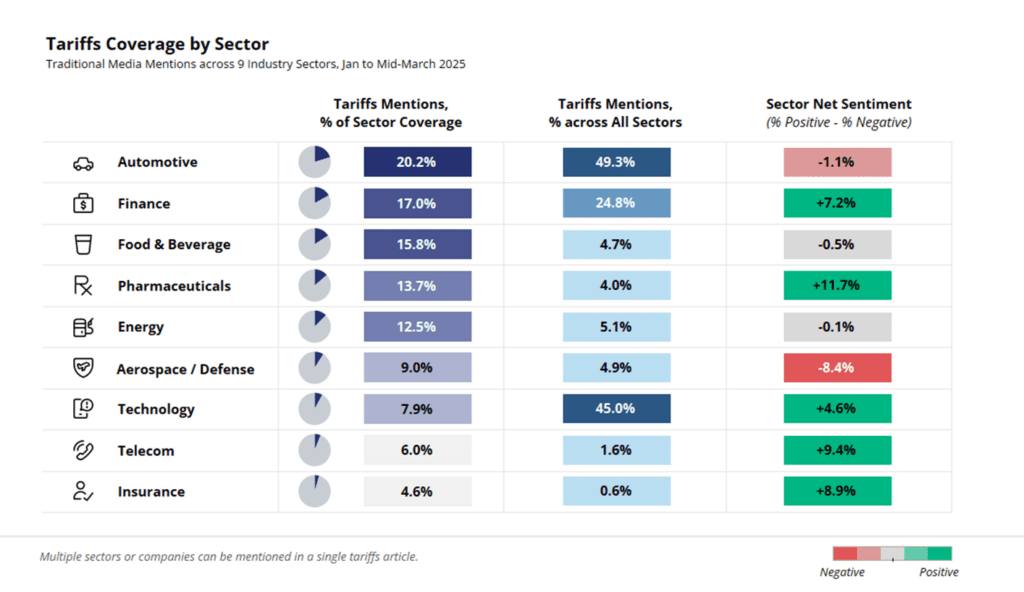The tariffs media cycle is at an all-time high, with coverage increasing 39% in the first quarter of 2025 alone compared to the entirety of 2024. This surge presents both risks and opportunities for companies across industries. While some brands face reputational challenges, others are leveraging the moment to showcase economic expertise and commitment to domestic investments.
Understanding how different sectors are being covered in the media can help communications leaders craft more effective messaging strategies. This blog will breakdown the following charts and explore how key industries are navigating the tariffs conversation:


Finance & Insurance: Seizing Thought Leadership Opportunities
Finance and insurance firms have found a silver lining in the tariff discussions, benefiting from media interest in their market insights. Coverage has been positive for firms providing economic forecasts, investment strategies, and financial products designed to hedge against trade volatility. This sector’s proactive approach in addressing tariff implications underscores the power of positioning expertise as a media asset.
Tech & Pharma: The ‘Made in America’ Advantage
Technology and pharmaceutical companies are tapping into the growing interest in domestic manufacturing. The media has responded favorably to companies highlighting investments in U.S. production, with Big Tech firms receiving positive attention for securing tariff exemptions on key components like semiconductors. However, companies must balance these narratives carefully. Overstating ‘Made in America’ claims without tangible action could invite scrutiny from skeptical audiences.
Auto & Aerospace: Facing Supply Chain & Cost Pressures
For auto and aerospace companies, tariffs have primarily driven negative coverage centered on rising manufacturing costs and potential operational delays. These industries rely heavily on global supply chains, making them vulnerable to cost fluctuations. The media is closely watching how these companies navigate higher expenses, with a shift in focus likely if price hikes begin impacting consumers directly. Companies in these sectors may benefit from transparency in their supply chain adaptation strategies, positioning themselves as resilient leaders amid economic uncertainty.
Agriculture & Energy: Bracing for Consumer Price Scrutiny
Tariffs on agricultural goods and energy imports, particularly from Canada, have heightened concerns over consumer price increases. While media coverage currently focuses on investor sentiment and company performance, this may shift as higher costs trickle down to consumers. Communications teams in these industries should be prepared for intensified scrutiny and develop messaging that addresses both market challenges and proactive company responses.
Reputational Risks & Internal Communications Challenges
Beyond external media coverage, tariffs are also creating internal communications challenges. Employees at global companies are increasingly worried about workforce reductions due to trade policy changes. Though labor-related narratives are not yet dominant in media coverage, when they do arise, they spark significant social media reactions. Transparent internal communications can help mitigate employee concerns and prevent negative narratives from escalating externally.
Key Takeaways for Communications Leaders
- Resilience is Key: Supply chain-dependent sectors must communicate operational stability to mitigate reputational risk. Be transparent around solutions to consumer price fears.
- Seize the Moment: Companies less affected by tariffs can stand out by showcasing expertise navigating through trade volatility or amplifying their commitment to US investments.
- The Narrative will Shift: If tariffs have staying power, expect the media to shift to scrutiny of company resilience plans or speculations of consumer price gouging. Positive sentiment will be earned through messaging that aligns with stakeholder concerns.
With tariff discussions continuing to dominate headlines, strategic and sector-specific messaging will be critical in shaping how companies are perceived. Communications leaders who stay ahead of the evolving media landscape can turn challenges into opportunities, strengthening their brands even in a volatile trade environment.
To learn more about where we source our data and even request a full report walkthrough, contact us.
Author: Azhar Unwala, SVP of Client Insights & Analytics